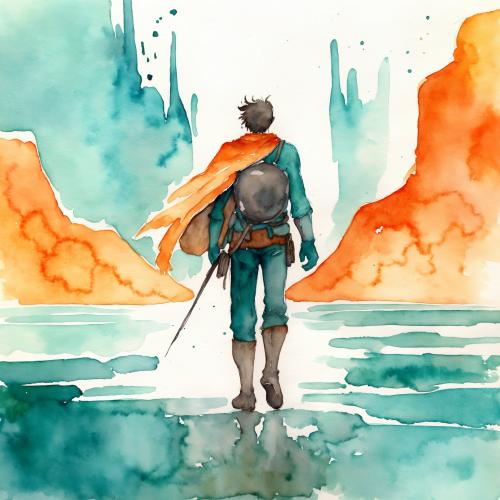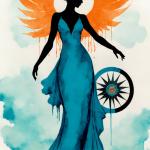Explore the fascinating parallels and divergences between Joseph Campbell's Hero's Journey and tarot's Fool's Journey. This article illuminates how these archetypal narratives reflect our personal growth, offering fresh perspectives on tarot interpretation and self-discovery.
In the vast landscape of human experience, we find ourselves drawn to stories. Not just any stories, mind you, but those that resonate deep within our psyche, echoing the rhythms of our own lives. Two such narratives have captured the imagination of seekers and storytellers alike: Joseph Campbell's Hero's Journey and the tarot's Fool's Journey.
At first glance, these two paths might seem as different as chalk and cheese. One's the stuff of epic tales and blockbuster films, while the other's often associated with mystical musings and introspective card-flipping. Yet, when we look closer, we find that these journeys are more like distant cousins than strangers - each offering a unique map of the human experience.
Let's embark on a little compare and contrast adventure, shall we? Don't worry, no sword-wielding or cliff-jumping required.
The Hero's Journey: Campbell's Cosmic Obstacle Course
Joseph Campbell, in his seminal work "The Hero with a Thousand Faces," outlined a pattern he observed in myths and stories across cultures. This monomyth, or Hero's Journey, follows a protagonist who ventures from the ordinary world into a realm of supernatural wonder, faces fabulous forces, wins a decisive victory, and returns with the power to bestow boons on their fellow humans.
The stages of the Hero's Journey, in brief:
- Ordinary World
- Call to Adventure
- Refusal of the Call
- Meeting the Mentor
- Crossing the Threshold
- Tests, Allies, Enemies
- Approach to the Inmost Cave
- Ordeal
- Reward (Seizing the Sword)
- The Road Back
- Resurrection
- Return with the Elixir
The Fool's Journey: Tarot's Existential Walkabout
The Fool's Journey, on the other hand, is a concept in tarot that sees the 22 Major Arcana cards as stages in a person's spiritual and psychological development. It starts with The Fool (card 0) and ends with The World (card 21), each card representing a lesson or experience along the way.
The stages of the Fool's Journey, briefly:
- The Fool
- The Magician
- The High Priestess
- The Empress
- The Emperor
- The Hierophant
- The Lovers
- The Chariot
- Strength
- The Hermit
- Wheel of Fortune
- Justice
- The Hanged Man
- Death
- Temperance
- The Devil
- The Tower
- The Star
- The Moon
- The Sun
- Judgement
- The World
Now, let's play spot the difference (and similarity).
Parallel Paths: Where Hero Meets Fool
Both journeys begin with a protagonist stepping out of their comfort zone. The Hero leaves the Ordinary World, while The Fool steps off the cliff into the unknown. It's that moment when you decide to learn a new skill, start a relationship, or finally clean out the garage - a mix of excitement and "what have I gotten myself into?"
Both paths involve mentors and guides. In the Hero's Journey, this is explicitly "Meeting the Mentor." In the Fool's Journey, we encounter various archetypal figures like The Magician and The High Priestess, who offer different kinds of wisdom and guidance.
Challenges and trials feature prominently in both narratives. The Hero faces "Tests, Allies, Enemies," while the Fool encounters obstacles throughout their journey, particularly with cards like The Tower or Death. It's life's way of asking, "How badly do you want this?"
Both journeys culminate in a form of transformation and return. The Hero returns with the Elixir, while the Fool reaches The World, symbolizing completion and integration. It's the equivalent of coming home after a long trip, somehow both changed and more yourself than ever.
Diverging Paths: Where Fool and Hero Part Ways
The Hero's Journey is often more linear and goal-oriented. There's a clear mission, a definite "bad guy" to overcome, and a specific boon to bring back. The Fool's Journey, however, is more cyclical and introspective. It's less about slaying dragons and more about understanding why dragons exist in the first place - and maybe realizing you are the dragon.
The Hero's Journey emphasizes external challenges and rewards, while the Fool's Journey focuses more on internal growth and self-discovery. One is more about doing, the other about being.
The role of choice differs too. The Hero often faces a clear "Refusal of the Call" stage, a moment of hesitation before committing to the journey. The Fool, symbolically stepping off a cliff, embodies a more immediate embrace of the unknown. It's the difference between deliberating over a life change and spontaneously deciding to move to Bali.
Practical Applications: Bringing the Journeys Home
Understanding these journeys can enrich your tarot practice and personal growth work:
- In readings, consider which journey the querent seems to be on. Are they facing external challenges (Hero) or internal ones (Fool)?
- Use the Hero's Journey stages to add depth to your interpretation of a tarot spread. How might The Tower represent the Hero's "Ordeal"?
- Reflect on your own life. Which journey resonates more with your current path? How can insights from both enhance your understanding of your experiences?
- Create spreads that incorporate elements from both journeys. For example, a "Mentor and Magician" spread to explore guidance in your life.
- Use the Hero's Journey to understand plot structures in stories, and the Fool's Journey to delve into character development.
In the end, both the Hero's Journey and the Fool's Journey offer profound insights into the human experience. They remind us that life is both an epic adventure and an introspective wandering, filled with challenges, growth, and transformation.
So, whether you see yourself as a sword-wielding hero or a wide-eyed fool (or perhaps a bit of both), remember that every step of your journey is valuable. After all, it's not about the destination - it's about who you become along the way.
Now, shuffle that deck, embrace your inner hero-fool, and see where the journey takes you. Who knows? You might just save the world - or at least make peace with your laundry pile. Both are heroic in their own way.
Comments are not enabled for this post yet






